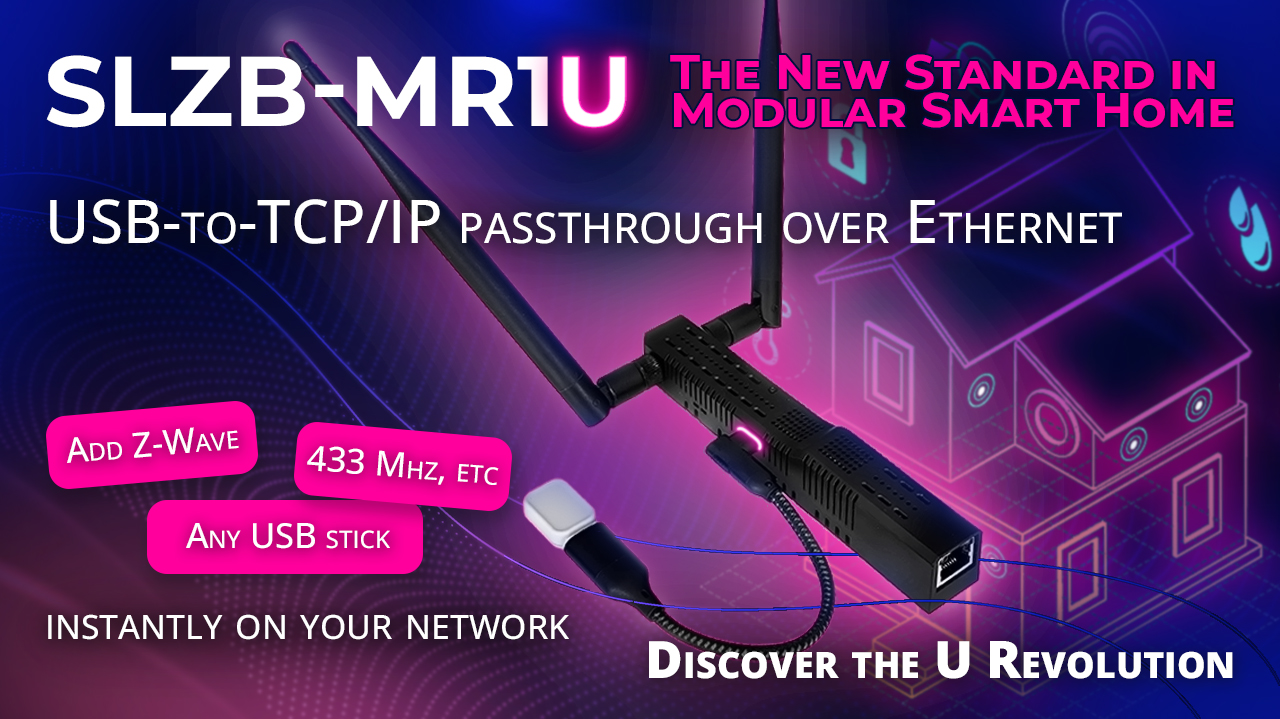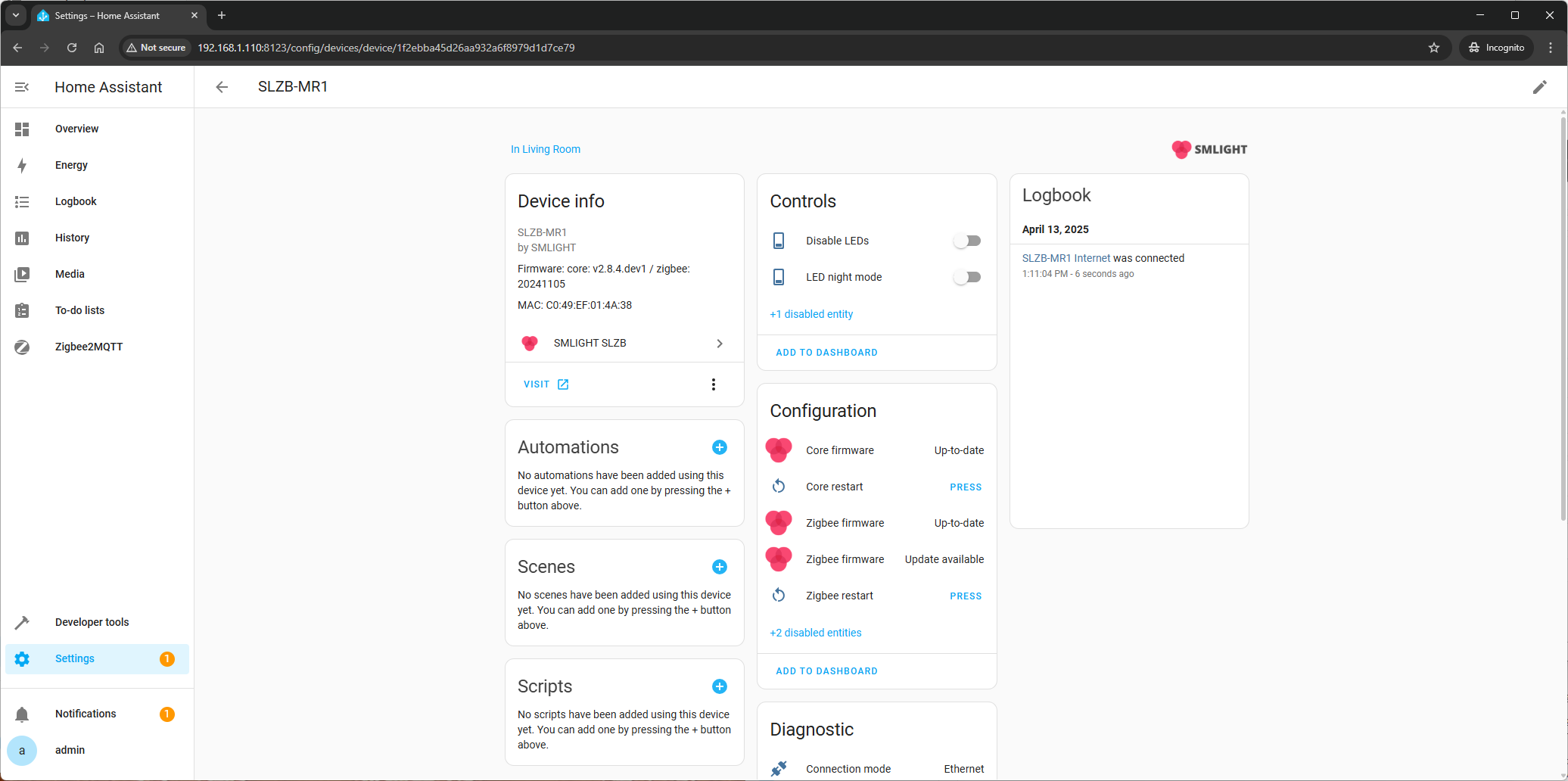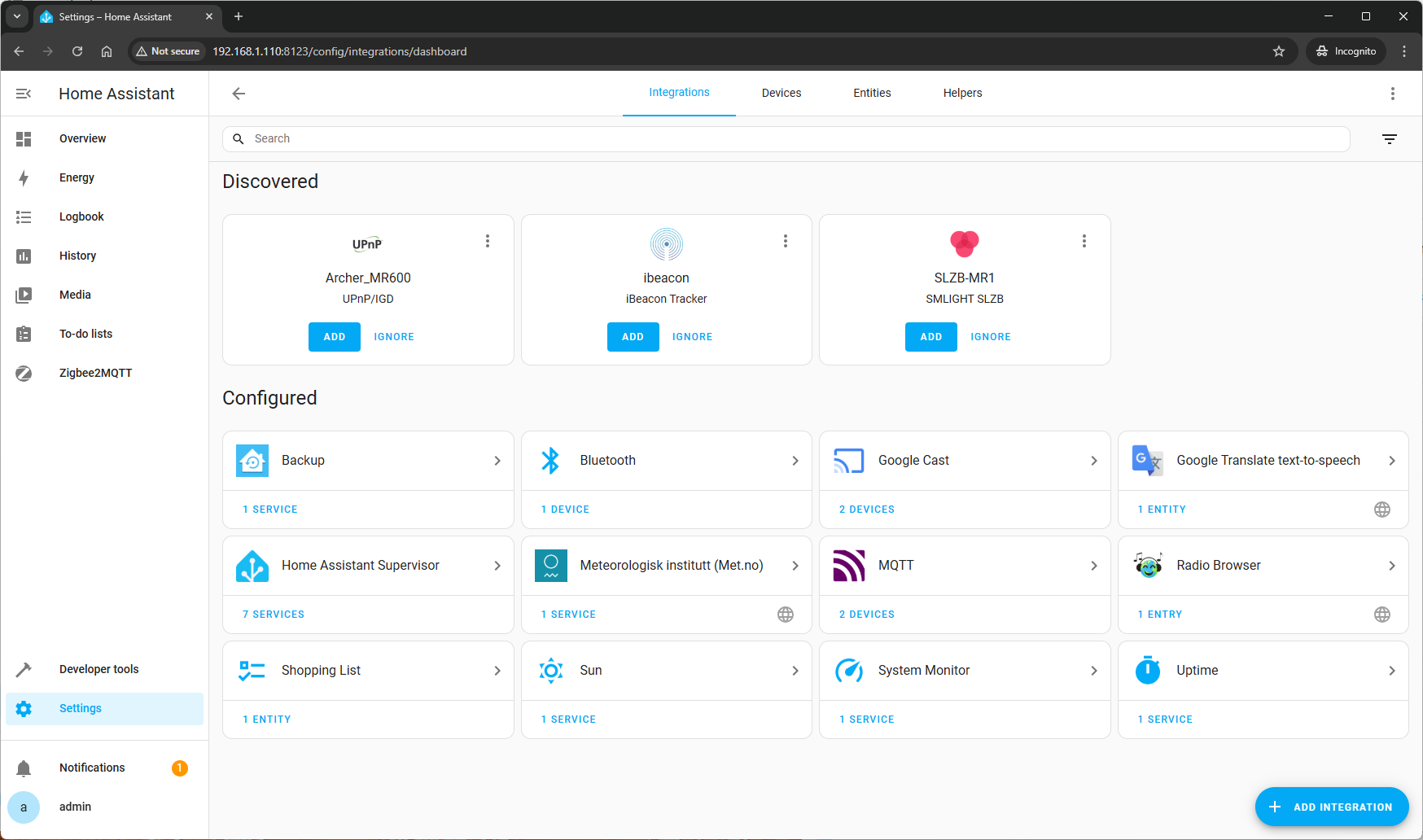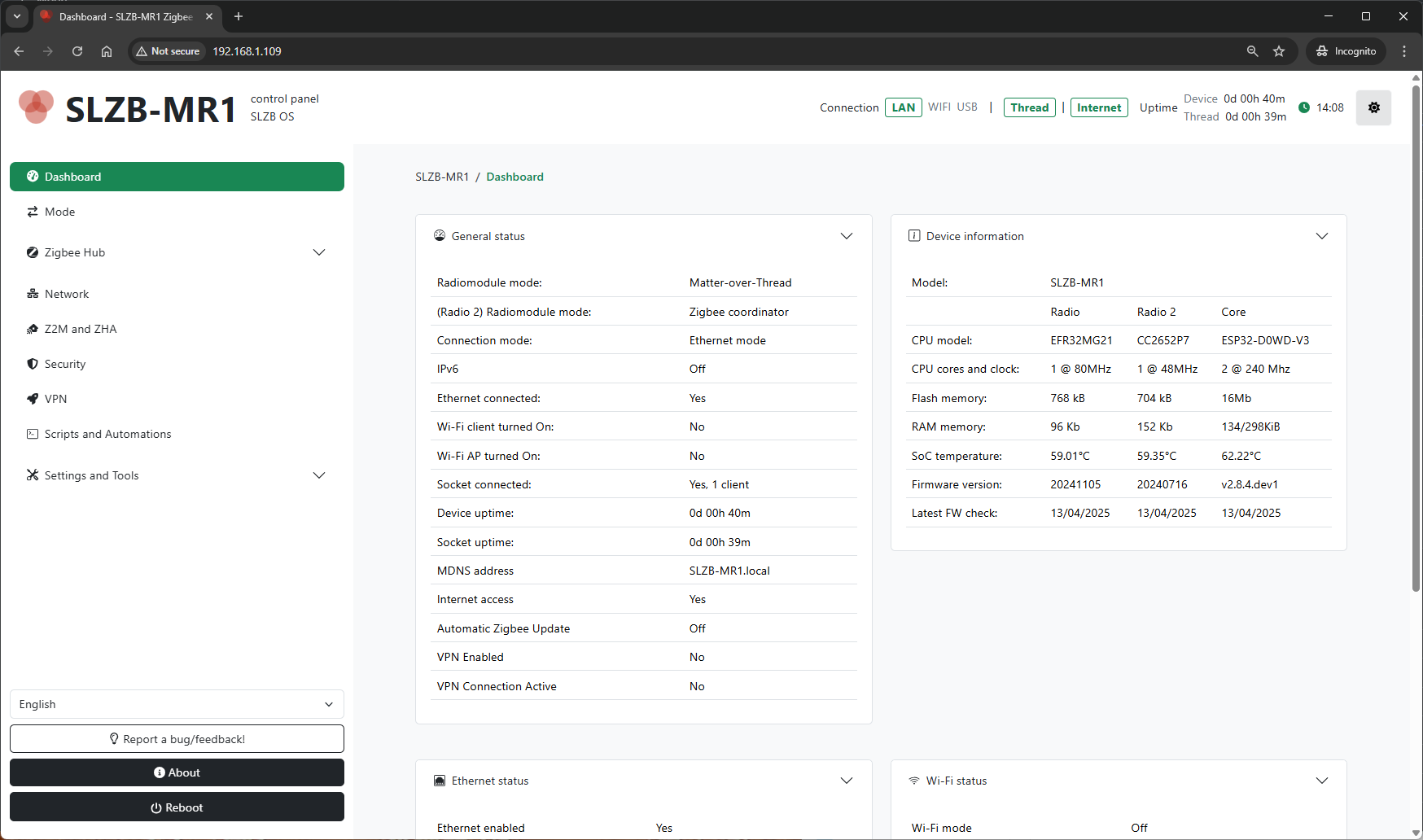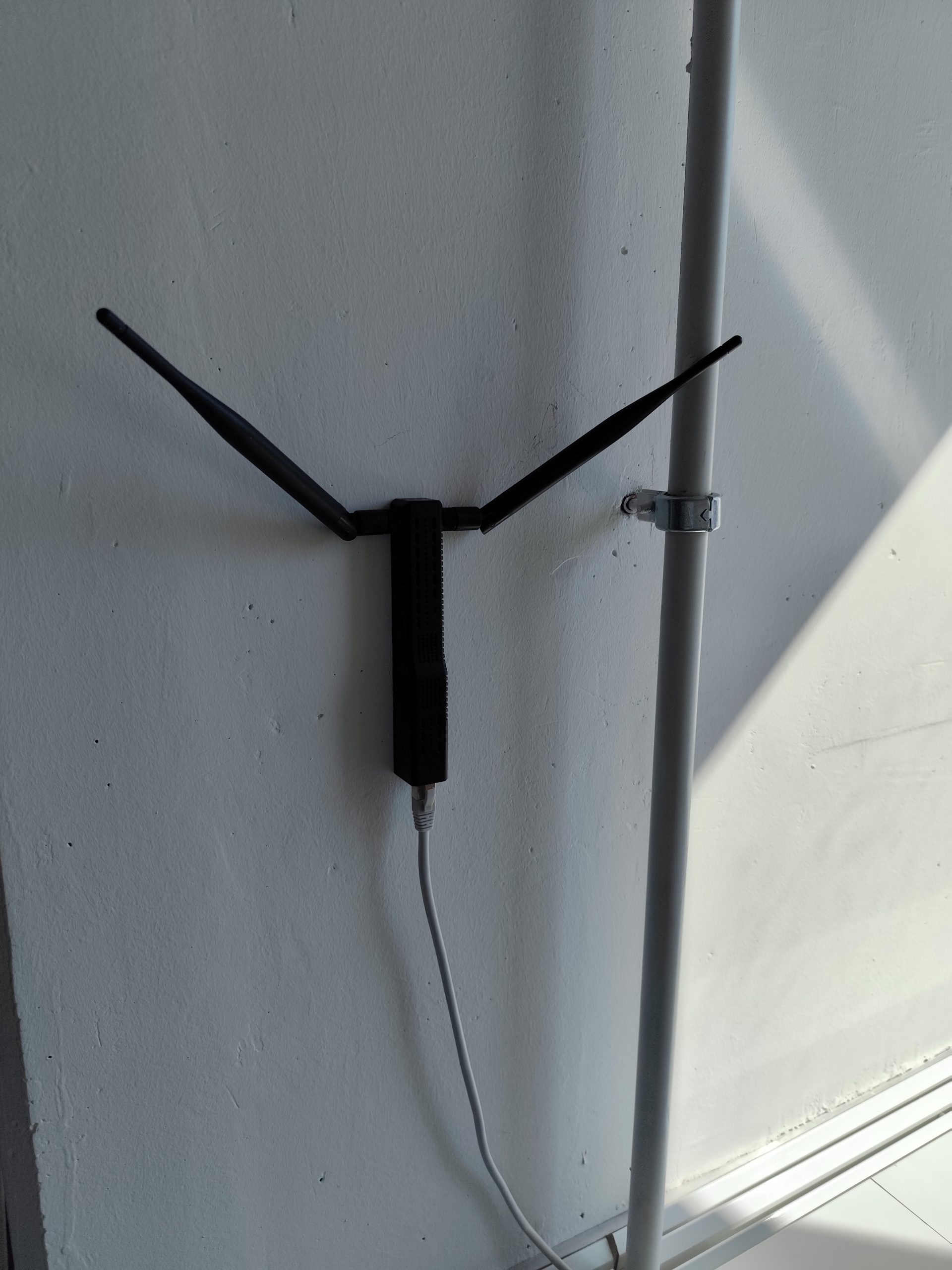WORLDWIDE DELIVERY:
- Aliexpress 1 – click here – available!
- Aliexpress 2 – click here – available!
- Authorized partner’s store – click here – available!
IMPORTANT UPDATE FOR NEW AND EXISTING CUSTOMERS
IMPORTANT UPDATE RE USB PASSTHROUGH FUNCTIONALITY – 27 AUGUST 2025 – Notice
🔥 SLZB-MR1U — Modular Zigbee / Thread / Z-Wave / USB Coordinator Over Ethernet
SLZB-MR1U is the next-generation smart home LAN
adapter from
SMLIGHT.
It
builds on the solid foundation of
SLZB-MR1, adding
USB passthrough over Ethernet
— making it the first
fully modular smart home coordinator
on the market.
🧩 Use it for Zigbee, Thread, + Z-Wave, or any USB-based protocol — all from a single, compact, Ethernet-connected device (see “USB passthrough” section for usage config).
✅ Key Features
-
🐝 Zigbee 3.0 support via Texas Instruments CC2652P (also could work in Thread Border Router mode)
-
🌐 Thread Border Router capability via EFR32MG21 (also could work in Zigbee mode).
-
🔌 USB Passthrough over TCP/IP — connect and access USB devices over the network (e.g., Z-Wave dongles). (see “USB passthrough” section for usage config).
-
📶 Wi-Fi and Bluetooth built-in (ESP32)
-
💡 Modular architecture — connect any USB device via port or USB hub (see “USB passthrough” section for usage config)
-
⚡ LAN + PoE support for stable power and network
-
🔄 Fully compatible with:
-
Zigbee2MQTT
-
Home Assistant
-
OpenThread
-
Z-Wave JS (via USB stick) or other protocol
-
-
💻 Plug-and-play, SLZB-OS powered
🧠 What Makes MR1U Unique?
Unlike typical LAN coordinators, SLZB-MR1U includes a USB host interface that allows you to:
-
Connect USB dongle (e.g., Z-Wave, Matter, BLE, custom RF, etc.)
-
Access that USB device over Ethernet using TCP/IP passthrough
-
Use a USB hub to run multiple devices simultaneously (e.g., Zigbee + Thread + Z-Wave + ) (see “USB passthrough” section for usage config).
-
Expand your smart home setup without changing hardware
🎯 Ideal for power users, integrators, and future-proof installations.
🔌 Connectivity Options
-
🌐 Ethernet (with PoE) — stable & wired
-
📶 Wi-Fi — for flexible placement
-
🔋 USB-C — alternative power input
-
🧩 USB-A host port — for radio/module expandability (see “USB passthrough” section for usage config).
🔌 USB Passthrough over Ethernet — Expand Like Never Before
One of the most powerful features of SLZB-MR1U is its USB passthrough capability over TCP/IP. This allows you to connect external USB devices — such as Z-Wave sticks, additional Zigbee coordinators, or custom UART-based modules — and access them over Ethernet just like they were locally plugged into your PC or smart home server.
✅ Compatible USB-to-UART chipsets:
-
CP210x (Silicon Labs)
-
PL2303 (Prolific)
-
CH340 / CH341 (WCH)
-
CH9102 (WCH, newer alternative to CH340)
These are the most commonly used chipsets in USB Zigbee, Z-Wave, or Thread dongles — making MR1U compatible with virtually all modern USB-based smart home radios.
💡 Use Case Example:
Plug a Z-Wave USB stick into the MR1U, and connect it from Home Assistant usingtcp://192.168.1.100:6638– no local USB ports needed!
⚠️ Power Considerations
Some USB devices (especially high-powered
dongles or hubs) may require
external power
to function reliably.
If you’re connecting:
- Power-hungry radios like Z-Wave long-range sticks
-
Or USB sticks with internal LEDs or extra features
👉 We recommend using a powered USB hub to ensure stable operation.
⚠️ Can I power the device using both PoE and
USB-C at the same time?
A: ❌ No
— never power the SLZB-MR1U with both PoE and
USB-C simultaneously.
Unlike the SLZB-MR1, the SLZB-MR1U features a direct internal connection between PoE power and the USB port. This design enables USB passthrough to function correctly when powered via PoE — delivering power to connected USB devices.
If you add USB-C power while PoE is already active, you risk damaging the board due to conflicting power sources.
🔌 Use only one power method at a time:
PoE (if available),
or USB-C (when PoE is not available).
Protect your hardware — never combine both
❓ Frequently Asked: “Can It Really Do That?”
Q: 💡 Wait… I can actually connect a USB
Z-Wave stick to this and use it over
Ethernet?
A: ✅
Yes — just plug the stick into the MR1U, and
connect to it using
tcp://
from Z-Wave JS or Home Assistant. No drivers, no
tricks. It works.
Q: 💡 Will it work with my Zigbee dongle
based on CH340 or CP2102?
A: ✅
Absolutely. The MR1U supports the most common
USB-UART chipsets:
CH340/CH341, CP210x, PL2303, CH9102.
Q: 💡 Can I use more than one USB device at
the same time?
A: ❌
Not now.
Q: 💡 I don’t have PoE. Can I still use
Ethernet mode if I power the device via
USB-C?
A:
✅
Yes — absolutely!
You can
run the SLZB-MR1U in
Ethernet mode
while powering it through
USB-C.
Here’s how to do it right:
🔌 Use a
powered USB hub
— plug your USB stick (e.g., Z-Wave) into the
hub, and also connect a
power supply
to the hub’s power input.
Then plug the hub into the MR1U’s USB port.
Ethernet stays active — no PoE needed.
Q: 💡 Is this just some sort of trick or
tunneling workaround?
A: ✅
No tricks. The passthrough is native. The USB
device becomes available over TCP just like with
ser2net or
USBIP, but embedded directly
into the SLZB-MR1U hardware.
Q: 💡 Will I need to install anything special
on the USB device?
A: ✅
No. The MR1U presents the device exactly as-is.
If it works over USB on your PC, it’ll work over
the network with MR1U.
Q: 💡 Do I need to configure anything to make
this work?
A: ✅
Very little — simply enable USB passthrough in
the web interface, and connect using the exposed
IP:Port. That’s it.
Q: 💡 Can I flash devices like Z-Wave via
this USB port?
A: ✅
Technically yes — but flashing over TCP is more
sensitive to timing. For production or critical
flashing, we still recommend direct USB.
Q: 💡 What happens if my USB stick draws too
much power?
A: ✅
Use a
powered USB hub. MR1U provides limited current via USB –
high-power devices (like long-range Z-Wave
sticks) may need external power.
Q: ⚠️ Can I power the device using both PoE
and USB-C at the same time?
A: ❌ No
— never power the SLZB-MR1U with both PoE and
USB-C simultaneously.
Unlike the SLZB-MR1, the SLZB-MR1U features a direct internal connection between PoE power and the USB port. This design enables USB passthrough to function correctly when powered via PoE — delivering power to connected USB devices.
If you add USB-C power while PoE is already active, you risk damaging the board due to conflicting power sources.
🔌 Use only one power method at a time:
PoE (if available),
or USB-C (when PoE is not available).
Protect your hardware — never combine both
PHOTOS
Technical Specifications – SLZB-MR1U
Radio Chips:
- Texas Instruments CC2652P7
-
- Zigbee 3.0 support (Zigbee2MQTT & ZHA compatible).
- Thread (Matter-over-Thread) support (Open Thread Border Router) .
- Ideal for Zigbee networks, works perfect also with Thread networks.
- +20 dBm TX power with built-in PA.
- 144kB+8kB RAM, 704kB Flash.
- Silicon Labs EFR32MG21
-
- Zigbee 3.0 support (Zigbee2MQTT & ZHA compatible).
- Thread (Matter-over-Thread) support (Open Thread Border Router).
- Ideal for Thread networks, works perfect also with Zigbee networks.
- +20 dBm TX power.
- 96 KB RAM, 1024 KB Flash.
Supported Protocols:
-
- Zigbee 3.0 (Zigbee2MQTT, ZHA), at the same time with Thread.
- Thread (Matter-over-Thread), at the same time with Zigbee.
- Supports simultaneous or switchable operation for multiradio environments.
- Wi-Fi.
- Other protocols based on External USB sticks.
Connectivity:
- USB-C for data and power
- Ethernet connection
- USB-C passthrough
Firmware:
-
Radio firmware support
-
- Compatible with TI Z-Stack (for CC2652P7)
- Compatible with SL Ember/EZSP stack (for EFR32MG21).
-
- Radio firmware Updating via web-interface
- SLZB-OS
- Compatible with SLZB-OS versions 2.9.7 and up).
-
SLZB-OS supported functionality:
-
- VPN, 20+ languages, Scripts support, Network settings, Security, Dashboard, zHub mode, mode switcher, OTA firmware updates etc.
-
Antenna:
- Dual external antenna SMA female connectors (one for each radio SoC)
- PCB antenna for Wi-Fi and Bluetooth.
- 2x pre-packed high-gain 2.4 GHz antennas included
Power Supply:
- PoE powered, POE 48V supported
- Powered via USB-C (5V DC)
- Low power consumption up to 1.5W (if both radio SoCs are running)
- !!! CANNOT be powered by Type-C and PoE at the same time. CAUTION!
Enclosure:
- Compact, durable ABS case with ventilation
- DIN rail and wall-mount compatible (3D models)
- Easy sticking with two-sided adhesive tapes
- Easy mounting with screws with screw set (screws, screw driver, ruler) included.
LED Indicators and peripheral:
- Independent status LEDs for each radio (6 service LEDs in total: 2 LEDs for Core SoC, 2 LEDs for CC2652P SoC, 2 LEDs for EFR32 SoC,)
- Multibutton: supports many functions (mode switch, reset etc).
FUNCTIONS

CC2652P + EFR32
Zigbee & Thread are based on the powerful chips CC2652P7 and EFR32 from TI and SL, reliability confirmed by thousands of users

LAN or USB
Use SLZB-MR1U as Zigbee 3.0 to LAN, WiFi or USB. Forget about separate devices. Change mode online or via button. Moreover, USB could be used to Expand with external USB devices.

PoE power
You can power your SLZB-MR1U device either through PoE or Type-C. NOT SIMULTANEOUSLY!!! PoE 802.5af standard is supported

+20dB +5dB
Zigbee 3.0 SLZB-MR1U adapter has +20dB amplifier on board & +5dB antenna. Cover your farthest locations
FIRMWARE

PRE-FLASHED
Just plug-and-play. You will get your SLZB-MR1U pre-flashed and ready to use

Coordinator or Router
Supports both Zigbee 3.0 modes – Coordinator or Router. Just flash over the web interface appropriate firmware

ADJUSTABLE
Full control of your device. Need to change mode from LAN to USB? Just one click. Want to turn off Power LED? One click!i

SECURE
Control access to the Zigbee 3.0 SLZB-MR1U adapter’s settings through secure login and password
CHIPSETS AND TECHS

ESP32
Powerful ESP32 chip makes control over all the functions of the device

W5500
Reliable Ethernet SoC from Wiznet takes care on stable Ethernet connection

PSRAM
Additional PSRAM included (standard ESP32 RAM is about 500kB, while here we have 2Mb of PSRAM).

CC2652P + EFR32
Zigbee & Thread are based on the powerful chips CC2652P7 and EFR32 from TI and SL, reliability confirmed by thousands of users
UPDATES

REMOTE ZIGBEE UPD
The only Zigbee coordinator with the option to update Zigbee chip over web-interface just with one click!

REMOTE ESP32 UPD
ESP firmware could be updated distantly. Full control wherever you are!

ESP32 Autoboot
SLZB-MR1U features auto boot mode for ESP32. If you want to flash over USB – just plug-and-do!

DIY PINOUTS
SLZB-MR1U is a DIY enthusiasts friendly: it contains pinouts for both ESP32 and CC2652P chips
USER FRIENDLY

EASY TO PLACE
Want to install it on the wall or under the table? Use doulbe sided adhesive tape or screws, SLZB-MR1U fits both!

NEWBY? MANUAL!
Do not know how to start? No worries, exhaustive manual is included!

POWERFUL ANTENNA
Need co cover with Zigbee network big area? No worries, powerful antenna is included!

TINY DESIGN
Now you can put your adapter wherever you want! SLZB-MR1U is a small and tiny!
OTHER

6X LEDS
Do you like responses from your devices with LED? SLZB-MR1U has 6 LEDs for intercation with the users!

BUTTON
Control device mode and other functions through physical button.

ROTATABLE ANTENNA
Rotatable in 3 dimensions antenna secures best positions for the best signal

MADE IN UKRAINE
SLZB-MR1U designed, developed and tested in Ukraine. Ukrainian quality guaranteed.
SMLIGHT SLZB-MR1U FREQUENTY ASKED QUESTIONS (FAQ)
Does SLZB-MR1U works with Home Assistant out of the box?
Yes, it does. Just plug in SLZB-MR1U into your LAN Ethernet or USB, and that is it. SLZB-MR1U is pre-flashed and ready to use.
Can I set up multiple SLZB-MR1U coodinators with one Home Assistant?
Yes, you can. You can set up as many SLZB-MR1U coordinators as you want with one Home Assistant. For that, you just need to run a separate instance of Zigbee2MQTT for each coordinator. We have now received feedback from our lovely Customers about using 6 items with one Home Assistant. Please also note that you can connect to devices that are outside your LAN network, e.g., somewhere in another location with access to the internet. More details can be found in this Article of the official manual.
Overall system architecture with multiple adapters looks like this:
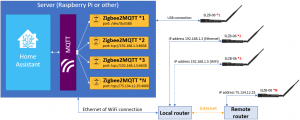
How to select mode USB/Ethernet? Any physical switches?
The device can be switched between USB or Ethernet either through a web-interface or by button. Just short press – and the work mode changed. Switching by web interface allows changing the work mode distantly. Please note, simultaneous power by PoE and Type-C is not allowed in SLZB-MR1U
Do I need to change powering either from POE or USB? Any switch?
POE powering and Type-C power should not be ON at the same time. Please choose either Type-C or PoE, but not both.
Can I update firmware distantly, without physical access to the SLZB-MR1?U
Yes, you can. Both main chips used in SLZB-MR1U (CC2652P, EFR32 and ESP32) can be updated distantly from the other global point. That makes the device suitable for installation in rare-visited locations or installation places.
Does it supports POE powering?
Yes, it does. The device support POE standard IEEE 802.3af. That is the “basic” POE widely used standard. Just plug and use; you do not need any other additional power cables and plugs. Please do not use Type-C powering and POE at the same time!
What is ESP32 Autoboot?
That is for “Pro” users who want to flash SLZB-MR1U with the type-C connection. ESP32 Autoboot means that the device contains a built-in programmer and schematic that allows flashing ESP32 without any additional activities: you do not need to press buttons to make ESP32 in flash mode, and you do not need to plug in additional programmers. The only thing you need – just to plug in type-C and start flashing. Easy.
Can I connect to type-C and RJ45 at the same time? Optoelectronic isolation at place?
Yes. The device contains optoelectronic isolation between USB and Ethernet parts. So you can plug in SLZB-MR1 to both RJ45 and type-C at the same time. However, please note, do not use POE and Type-C at the same time!
When close to ear, I hear little noise from the PoE transformer. Is it Ok?
The enclosure of the device contains vent holes, and when close to the ears, you can hear little noise from the POE transformer. The normal is if you can’t hear it more than 50 centimeters from the device.
WORLDWIDE DELIVERY:
- Aliexpress 1 – click here – available!
- Aliexpress 2 – click here – available!
- Authorized partner’s store – click here – available!
IMPORTANT UPDATE FOR NEW AND EXISTING CUSTOMERS
IMPORTANT UPDATE RE USB PASSTHROUGH FUNCTIONALITY – 27 AUGUST 2025 – Notice

